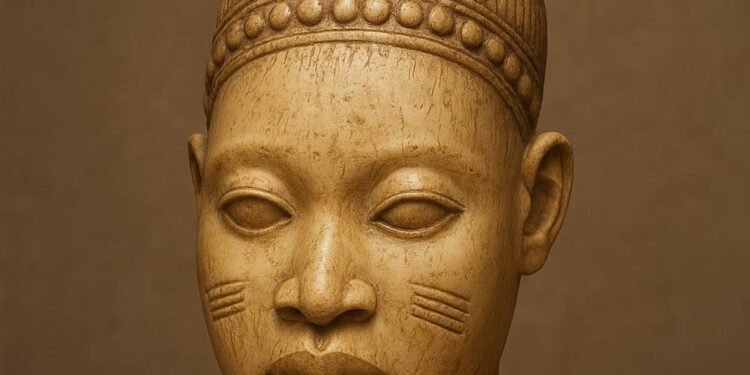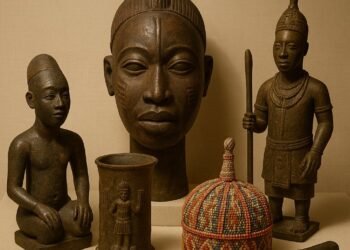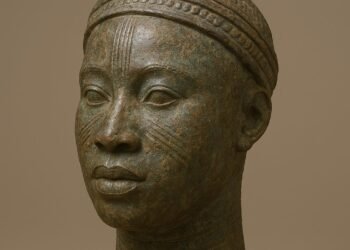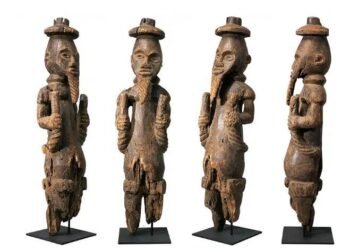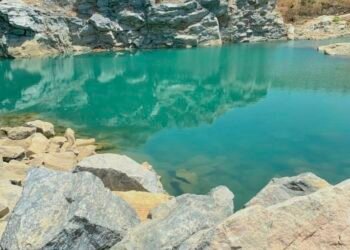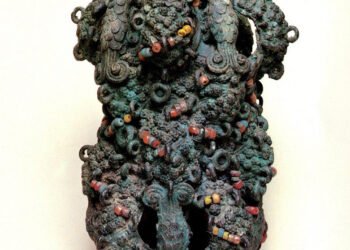Table of Contents
What the Owo Mask Reveals About Yoruba History
Probed between the fabled artistic traditions of Ile-Ife and the Benin Kingdom, the ancient city of Owo in Nigeria developed a unique visual language through its ritual masks.
These magnificent works of art are more than a show of artistic excellence but an expression of the spiritual beat of a people.
Crafted with outstanding skill from wood, terracotta, and ivory, Owo masks are sacred agents of interchange between the physical and spiritual realms. They have been used in ceremonies to pray to ancestors, promote social hierarchy, and model royal authority.
Every mask is a testament to cultural exchange and artistic hybridity, fusing Ife naturalism and Benin formalism.
Read Also: The Fascinating Origins of Oron Kingdom
These strong artifacts continue to fascinate historians and art aficionados alike, sustaining Owo’s rich tradition of distinctive ceremonial practice.
The Legend of Owo’s Holy Masks
All major art traditions have their beginnings in a legend, and the legend of the Owo masks begins with an odyssey.
Traditionally, the city itself was established by Ojugbelu, the youngest son of the great Oduduwa. There was a battle among family members for the inheritance, which caused Ojugbelu to break camp from Ile-Ife with his loyal chiefs.
Their movement east ceased where they created Owo, and Ojugbelu was first Olowo, or king. Owo’s history is grounded in Yoruba tradition but branches off onto its own distinct course. Its position, midpoint between major powers like Ile-Ife and the Kingdom of Benin, contributes to its divergence.
Owo’s evolution was shaped by a combination of political and cultural forces borrowed from its neighbors, forming a heritage that is connected yet singular within the larger regional context. Rather than merely borrowing foreign looks, Owo artists merged these influences among themselves to create something new.
Masks of this cultural blend retain memories of Benin’s ritual grandeur and Ife’s natural beauty, but each has its own individual character that is uniquely Owo.
Not only do such fusions make every mask a work of art, but they also serve as a record of cultural exchange.
The Artistry of Owo Masks
The making of an Owo mask was more than a technical undertaking; it was a challenging task that required knowledge of materials and their meanings.
Every element was carefully selected by craftsmen, from the wood for its ordinariness, to terracotta for its ritualistic connection, and precious ivory for its overt connection to power and status.
The creamy white tusks were painstakingly carved into intricate designs that shone with a natural luminosity.
Read Also: Discover the Beauty of Bwari Rock in Abuja, Nigeria
So highly reputed were Owo ivory craftsmen that Benin royalty in other kingdoms invited them to work in royal workshops in the 17th and 18th centuries.
What truly distinguished Owo artisanship was the innovative use of materials.
Whereas Benin craftsmen worked principally in brass, Owo artisans took ivory carving to a height of perfection never before known. They created elaborate ceremonial regalia, such as the orufanran, a dramatic costume featuring a jacket and trousers adorned with ivory ornaments.
This choice demonstrated both creative and resourceful confidence because Owo had access to elephant habitats.
Apart from ivory, artists augmented their work with metal inclusions, tinted patterns, and contrasting inlays of dark wood or coconut shell, which gave visual depth and symbolic sophistication to every piece.
The Visual Language of Owo Masks
Owo masks possess a distinctive visual language that commands attention immediately. Ife sculpture is concerned with refined perfection, and Benin art with formal grandeur; Owo artists found a middle path that balances the human and divine appeal.
Their masks combine realistic facial features with boldly designed geometric patterns, creating a strong tension between the familiar and the symbolic.
Look closely at an Owo mask, and you’ll notice broader facial features, fuller lips, and more pronounced facial markings than those found in pure Ife style works.
The agbodogin mask perfectly illustrates this approach with its white face framed by black trim and intricate patterns.
These forms of evidence show cultural exchange with the neighboring regions without Owo losing its unique identity. Crowns and headpieces are frequently much elaborated in numerous masks and instantly signal the spiritual or royal status of the wearer.
Most noticeably, perhaps, these carved faces portray actual emotion, from serene content to profound concentration, and as such, they appear accessible despite their ceremonial function.
This affective honesty allows the masks to serve as comprehensible mediators between the community members and the spiritual forces which they represent.
The Spiritual Power of Owo Masks
Owo masks transcend artistic expression, becoming living conduits between worlds.
In ceremonies throughout the year, these carved faces transform into spiritual vessels, particularly within the Egungun tradition, where they embody ancestral presence.
Each mask carries àse, the divine energy that connects communities to their heritage and maintains balance in the cosmic order.
During important festivals like Igogo, masked performers actively cleanse their communities, sweeping away negative energies and protecting against spiritual threats.
Some masks specialize in confronting darkness directly. The Igbudu mask, intentionally carved with frightening features, serves as a spiritual warrior against malevolent forces.
Its exact rituals remain closely guarded knowledge, adding to its powerful mystique. Other masks like the Osanmasinmi, which combines human features with a ram’s horns, stand watch over ancestral shrines, symbolizing the enduring strength of royal lineages.
These masks don’t just represent spirits; they become temporary homes for powerful energies that guide, protect, and renew the community.
Masks as Signs of Power and Status
In Owo society, masks served as external indicators of status and power. The materiality and craftsmanship of every mask conveyed clear messages about the wearer’s status within the community’s social hierarchy.
Ivory masks, for instance, were reserved for the Olowo and the highest chiefs, their gleaming surfaces advertising privileged access to valuable resources.
While borrowing ceremonial finery from Benin kings, such as coral bead crowns, the artists in Owo adapted these symbols to their own materials and aesthetics. In addition to ornament, masks also served active purposes in maintaining social norms. Even though documents are still inadequate for Owo specifically, neighboring regions demonstrate how masked figures played roles in judicial trials and succession rites.
Read Also: Arochukwu Long Juju Shrine: Unveiling Ancient Traditions
Secret societies likely employed masks in rituals that determined leadership transitions and resolved community disputes.
The presence of a mask would consecrate an ordinary gathering into a sacred assembling, giving terrestrial decisions the weight of spiritual law and reminding all who attended of the ancestral wisdom that guided their tradition.
Secrets of Owo Masks Still Unrevealed
Despite increasing knowledge about Owo masks, numerous secrets remain elusively beyond our grasp. The full ritual function of the intimidating Igbudu mask, whose features were deliberately designed to be frightening, remains unclear to scholars.
We are aware that it was meant to challenge evil forces, but the rituals and incantations that accompanied it are not known to have been recorded.
Similarly, recurring symbolic themes, such as snakes emerging from nostrils, recur in various regional styles of artwork; yet, their specific interpretation within Owo culture could be quite distinct from the meanings in Ife or Benin.
The fragile condition of these works contributes to the mysteries surrounding them. Time has not been kind to organic materials like wood and ivory, and terracotta figures have survived only in parts.
Every lost piece represents a lack of understanding of the artistic evolution and religious traditions of Owo. These precious questions remind us that aspects of cultural heritage resist complete interpretation, and an aura of enigma and fascination must be left for future generations.
A Living Legacy Maintained
Owo masks still play a significant role in shaping culture, long after they were first used in rituals. Today, artists in Nigeria and around the world draw inspiration from these old artworks, giving classic styles a fresh spin for today’s audience. This art talk bridges the past and the present, allowing art to evolve and grow.
The masks remain powerful icons of Yoruba culture, integral to cultural festivals and educational programs that preserve traditions.
Conserving these fragile artifacts poses continuous challenges. Nigeria’s tropical environment poses a risk to the organic materials used in mask-making, necessitating meticulous climate control and preservation skills.
World institutions collaborate with Nigerian experts to develop preservation methods that respect both the physical artifact and its cultural context.
Such collaborative efforts help ensure that Owo masks continue to endure as living cultural heritage, rather than stale museum artifacts, remaining relevant to future generations as objects of study and appreciation.
The Ongoing Tradition of Owo Masks
The Owo masks themselves are a testament to artistic ingenuity and cultural fantasy. The masks reflect the creative energy of a nation that drew inspiration from powerful neighbors in developing its own distinctive visual profile.
These masks are not decorations; they are of great importance in Yoruba culture and hold a great place within Nigeria’s heritage. Their continued relevance is not coincidental but rather their capacity to speak to individuals today with continued comprehension. Artists and thinkers continue to be inspired by these masks, fostering a renewed appreciation and preserving Africa’s cultural heritage.
These masks have traveled a considerable distance, transitioning from religious use to display in museums. It seems like old work can change but still be important today.
When we learn about and protect these pieces, we keep their beauty alive and pass on their significance to those who come after us.
The story of the Owo masks is still being written. More adventures and new ways of understanding them will help us learn even more about this amazing art.
